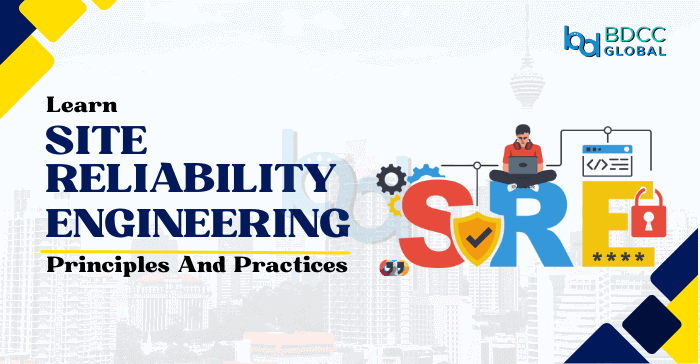
Have you ever wondered why Amazon’s online services seem to run flawlessly while you struggle with downtime and glitches? That causes you to lose customers to your competitors.
If yes, stick to this article, where we will explain SRE (Site Reliability Engineering), which is essential for scaling software systems and has become a critical part of IT industries. SRE ensures reliability across large projects by implementing DevOps Principles. The benefits are endless.
From Google to Netflix, many tech giants have adopted SRE principles as a crucial aspect of their IT operations. Understanding its basic principles and best practices is vital. It will support its proper implementation and help increase your company’s productivity.
7 Fundamental SRE Principles
First Principle: Embracing Risk
It involves carefully considering the trade-offs between the costs of improving reliability and its impact on customer satisfaction. Improving reliability comes at some cost, whether money, time, or energy. By accepting risk, you may recognize when this expense is unwarranted.
Principle 2: Automation
Automation is a critical aspect of the SRE role. Manually managing services gets more difficult as they increase and become more dispersed. Whether testing, software deployment, incident response, or team communication, automating tasks offers quick advantages, efficiency, and consistency.
Principle 3: Eliminating Toil
SRE aims to enhance operational efficiency by automating a maximum number of tasks to streamline operations. Toil refers to tedious or repetitive tasks that SRE teams must do to maintain system reliability. Eliminating toil is essential for enhancing pipeline velocity and scaling larger systems. SRE teams should limit the amount of toil they perform.
Principle 4: Service-Level Objectives
By converting customer satisfaction into an internal objective, Service Level Objectives (SLOs) assist in managing risk and budget for errors. Service level indicators (SLIs), a collection of measures that reflect what is most crucial to consumers, serve as the foundation for SLOs. By analyzing how customers use a service, SLIs can be developed to represent reliability for distinct user journeys.
Principle 5: Release engineering
Release engineering is one of the crucial SRE principles that focuses on delivering software in a consistent and repeatable manner. SRE automates the deployment process as much as possible to reduce manual intervention. It also aims to build in monitoring and testing at every stage of the deployment pipeline automation, which ensures that any bug can be caught and resolved quickly.
Principle 6: Monitoring
Monitoring enables the identification of any issues or errors in services. It also identifies potential problems and tries to resolve them using several tools. Uptime and availability are the main criteria for ensuring all services function as intended. Monitoring can provide valuable insights which can help teams make informed decisions.
Principle 7: Simplicity
Simplicity is among the finest SRE principles, emphasizing developing simpler systems. While this may seem counterintuitive, the goal is to create a reliable, consistent, and predictable procedure. While users may want more features, SREs understand that additional features can lead to more complicated problems.
Best Practices To Apply SRE To Your Project
By following these best practices, you can effectively apply the principles of SRE to your project and achieve high reliability, availability, and efficiency.
Determine acceptable levels of reliability
Identify your project’s adequate reliability level and strive to achieve it.
Empower management to take on predetermined levels of risk
Provide leadership with the authority and resources to take on predetermined levels of risk.
Build robust service level objectives and service level agreements
Set service level agreements (SLAs) and service level objectives (SLOs) that align with your company objectives.
Create a budget with room for error
Allocate resources in your budget that allow for potential failures and unforeseen circumstances.
Eliminate areas of high toil
Automation helps eliminate repetitive tasks and reduces the chances of errors. Partnering with DevOps consulting companies can be a wise choice as they have significant exposure to automating tasks and optimizing workflow.
Create case-dependent standards of efficiency
Set standards of efficiency that are tailored to each specific use case and scenario.
Monitor services and act on possible areas of improvement
Maintain a constant eye on your benefits to spot any potential problems and areas for development, then take the appropriate corrective action.
Document release standards and educate all stakeholders
Document your release standards and inform all stakeholders so everyone understands and follows them.
Investigate complex systems and invest in tools that improve system simplicity
Examine complex systems and spend money on tools that simplify procedures, making management and maintenance more straightforward.
Conclusion
These SRE principles and best practices can help your organization to achieve its goals. SRE teams use automation to eliminate the risk of human error, which allows organizations to achieve faster and more efficient delivery of products. Leading DevOps companies can also help you in adopting SRE for your workplace. Because, like DevOps, SRE is also about promoting collaborative and data-driven work culture for continuous improvement. Its principle and practices aim to improve the reliability of software systems. So, implement SRE today to take your software system to the next level.
For more help, you can dig into this platform to get the best DevOps consulting services.
BDCC
Latest posts by BDCC (see all)
- How AI Is Reshaping DevSecOps Governance - April 4, 2025
- Using AWS Auto Scaling to Handle Traffic Spikes Efficiently - April 1, 2025
- Disaster Recovery Strategies with Terraform: Building Resilient and Highly Available Infrastructure - March 28, 2025

